Wir benötigen Ihre Einwilligung zur Verwendung der einzelnen Daten, damit Sie unter anderem Informationen zu Ihren Interessen einsehen können. Klicken Sie auf "OK", um Ihre Zustimmung zu erteilen.
ASTM F2396-11
Standard Guide for Construction of High Performance Sand-Based Rootzones for Athletic Fields
Automatische name übersetzung:
Standard-Leitfaden für den Bau von Hochleistungs Sand-Based Rootzones für Sportplätze
NORM herausgegeben am 1.4.2011
Informationen über die Norm:
Bezeichnung normen: ASTM F2396-11
Anmerkung: UNGÜLTIG
Ausgabedatum normen: 1.4.2011
SKU: NS-53764
Zahl der Seiten: 11
Gewicht ca.: 33 g (0.07 Pfund)
Land: Amerikanische technische Norm
Kategorie: Technische Normen ASTM
Kategorie - ähnliche Normen:
Die Annotation des Normtextes ASTM F2396-11 :
Keywords:
athletic field, baseball, clay, cricket, football, natural turf, sand, soccer, softball, soil, sports field, sports turf, turfgrass, Sports field rootzone mixes--sand-based, ICS Number Code 97.220.10 (Sports facilities)
Ergänzende Informationen
| Significance and Use | ||||||||||||||||||||||||||||||||||||||||||
|
A dense, uniform, smooth, and vigorously growing natural turfgrass sports field provides the ideal and preferred playing surface for most outdoor field sports. Such a surface is pleasing to the spectators and athletes. A thick, consistent, and smooth grass cover also increases playing quality and safety by providing stable footing for the athletes, cushioning their impact from falls, slides, or tackles, and cools the playing surface during hot weather. Sand is commonly used to construct high performance sports turf rootzone systems. Sand is chosen as the primary construction material for two basic properties, compaction resistance and improved drainage/aeration state. Sands are more resistant to compaction than finer soil materials when played upon within a wide range of soil moisture conditions. A loamy soil that may provide a more stable surface and enhanced growing media compared to sand under optimal or normal conditions will quickly compact and deteriorate in condition if used in periods of excessive soil moisture, such as during or following a rainy season. A properly constructed sand-based rootzone, on the other hand, will resist compaction even during wet periods. Once compacted, sands are easier to decompact with the use of mechanical aeration equipment. Even when compacted, sands will retain an enhanced drainage and aeration state compared to native soil rootzones under the same level of traffic. As such, sand-based rootzones are more conducive to providing an all-weather type of playing surface. Properties of both the soil and grass plants must be considered in planning, constructing, and maintaining a high quality sports turf installation. Turfgrass utilized must be adapted to the local growing conditions and be capable of forming a thick, dense, turf cover at the desired mowing height. Unvegetated sand in and of itself is not inherently stable; therefore, it is imperative that grasses with superior wear tolerance and superior recuperative potential are utilized to withstand heavy foot traffic and intense shear forces. Sand does, however, have incredible load bearing capacity and if a dense, uniform turf cover is maintained, the sand-based system can provide a very stable, firm, smooth, and uniform playing surface. A successful sand-based rootzone system is dependent upon the proper selection of materials to use in the project. The proper selection of sand, organic amendment, soil and gravel is of vital concern to the performance of the system and this guide addresses these issues. During construction, consideration should be given to factors such as the physical and chemical properties of materials used in the area, freedom from stones and other debris, and surface and internal drainage. Maintenance practices that influence the playability of the surface include mowing, irrigation, fertilization, and mechanical aeration and are factors addressed in other standards (see Guides F2060 and F2269). Those responsible for the design, construction, or maintenance, or a combination thereof, of natural turf athletic fields for high-performance, all-weather purposes will benefit from this guide. A successful project development depends upon proper planning and upon the selection of and cooperation among design and construction team members. A high-performance, sand-based rootzone project design team should include a project designer, an agronomist or soil scientist, or both, and an owner’s representative. Additions to the team during the construction phase should include an owner’s project manager (often an expansion of role for the owner’s representative), an owner’s quality control agent (often the personnel that is employed in advance with the intent of becoming the finished project’s sports field manager), an owner’s testing agent (often an expansion of roles for the project’s agronomist/soil scientist), and the contractor. Planning for projects must be conducted well in advance of the intended construction date. This often requires numerous meetings to create a calendar of events, schedule, approvals, assessments, performance criteria, material sourcing, geotechnical reports, and construction budgets. Note 2—Other specifications on soils for athletic field construction have been published and have been considered during the development of this guide. |
||||||||||||||||||||||||||||||||||||||||||
| 1. Scope | ||||||||||||||||||||||||||||||||||||||||||
|
1.1 This guide covers techniques that are appropriate for the construction of high performance sand-based rootzones for sports fields. This guide provides guidance for the selection of materials, including soil, sand, gravel, peat, and so forth, for use in designing and constructing sand-based sports turf rootzones. 1.2 Decisions in selecting construction and maintenance techniques are influenced by existing soil types, climatic factors, level of play, intensity and frequency of use, equipment available, budget and training, and the ability of management personnel. 1.3 This guide offers an organized collection of information or a series of options and does not recommend a specific course of action. This document cannot replace education or experience and should be used in conjunction with professional judgment. Not all aspects of this guide may be applicable in all circumstances. This guide is not intended to represent or replace the standard of care by which the adequacy of a given professional service must be judged, nor should this document be applied without consideration of a project’s many unique aspects. The word “standard” in the title of this document means only that the document has been approved through the ASTM consensus process. 1.4 The values stated in SI units are to be regarded as the standard. The values in parentheses are for information only. 1.5 This standard may involve hazardous materials, operations, and equipment. This standard does not purport to address all of the safety concerns, if any, associated with its use. It is the responsibility of the user of this standard to establish appropriate safety and health practices and determine the applicability of regulatory requirements prior to use. |
||||||||||||||||||||||||||||||||||||||||||
| 2. Referenced Documents | ||||||||||||||||||||||||||||||||||||||||||
|
Ähnliche Normen:
Historisch
1.6.2011
Historisch
15.7.2012
Historisch
15.2.2013
Historisch
15.5.2009
Historisch
1.8.2012
Historisch
1.1.2007
Empfehlungen:
Aktualisierung der technischen Normen
Wollen Sie sich sicher sein, dass Sie nur die gültigen technischen Normen verwenden?
Wir bieten Ihnen eine Lösung, die Ihnen eine Monatsübersicht über die Aktualität der von Ihnen angewandten Normen sicher stellt.
Brauchen Sie mehr Informationen? Sehen Sie sich diese Seite an.


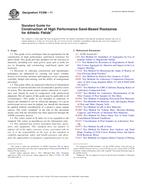
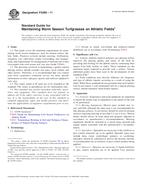 ASTM F2269-11
ASTM F2269-11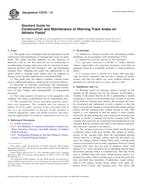 ASTM F2270-12
ASTM F2270-12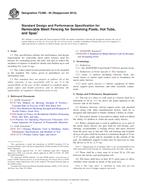 ASTM F2286-05(2013)..
ASTM F2286-05(2013)..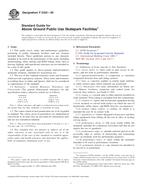 ASTM F2334-09
ASTM F2334-09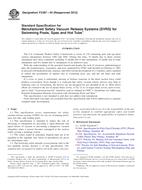 ASTM F2387-04(2012)..
ASTM F2387-04(2012)..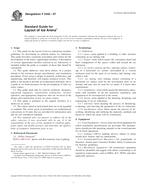 ASTM F2442-07
ASTM F2442-07
 Cookies
Cookies
